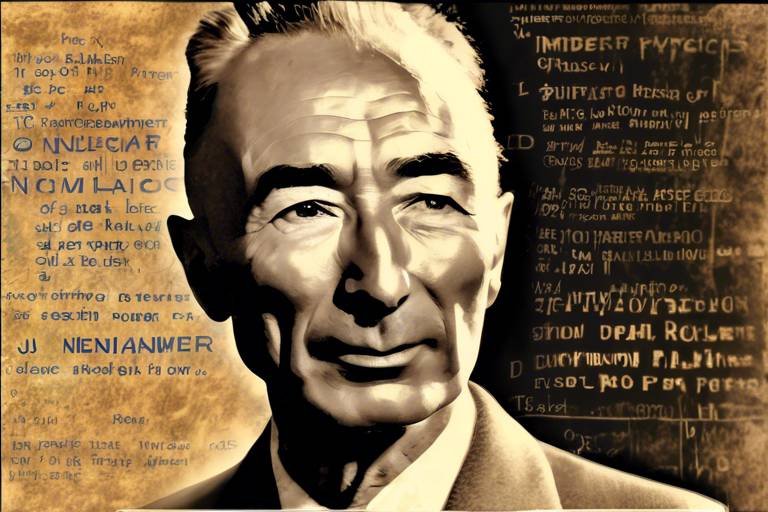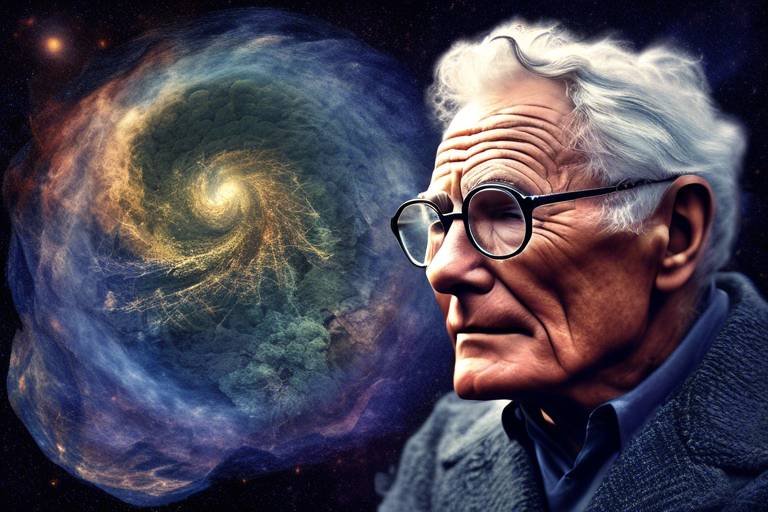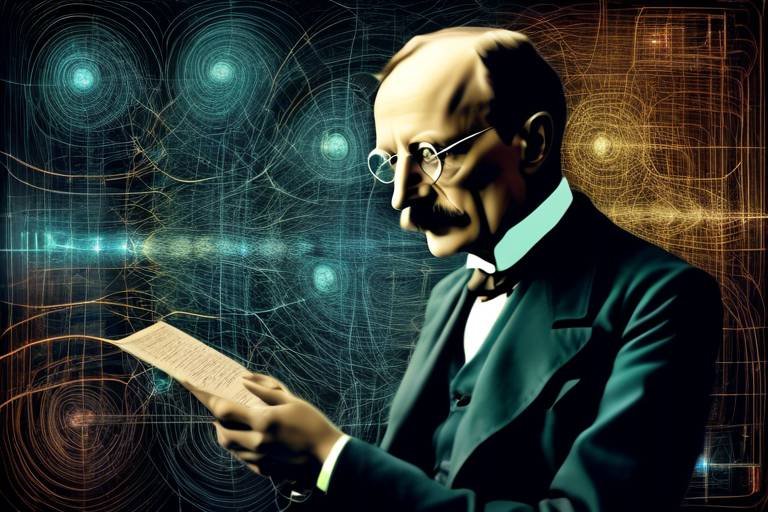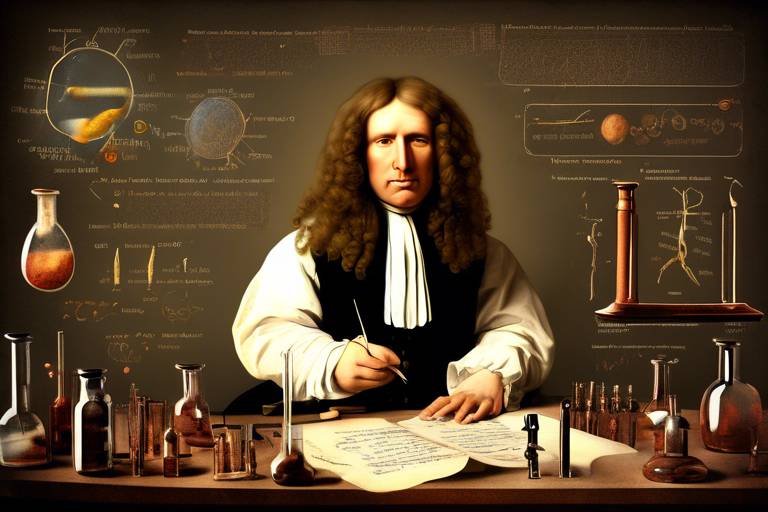The Work of J. Robert Oppenheimer in Nuclear Physics
When we think of the world-changing advancements in science, one name often rises to the top: J. Robert Oppenheimer. His contributions to nuclear physics not only transformed the scientific community but also altered the course of history. Oppenheimer, often dubbed the "father of the atomic bomb," played a crucial role in the development of nuclear weapons during World War II, but his influence extends far beyond that monumental project. His work in theoretical physics laid the groundwork for numerous advancements in our understanding of atomic structure and behavior. In this article, we will delve into the multifaceted contributions of Oppenheimer, exploring his early life, theoretical contributions, leadership in the Manhattan Project, and the ethical implications of his work.
Born on April 22, 1904, in New York City, Oppenheimer was the son of Jewish immigrants. His upbringing in a cultured environment fostered a deep appreciation for the arts and sciences. From a young age, Oppenheimer displayed a remarkable intellect and an insatiable curiosity about the universe. He attended Harvard University, where he majored in chemistry before shifting his focus to physics. Oppenheimer's academic journey took him to the University of Göttingen in Germany, where he studied under some of the most renowned physicists of the time, including Max Born. This period of intense learning and discovery equipped him with the tools he needed to make groundbreaking contributions to the field of nuclear physics.
Oppenheimer's theoretical work significantly advanced our understanding of quantum mechanics and nuclear physics. Among his most notable contributions is the Born-Oppenheimer approximation, a method that simplifies the mathematical treatment of molecular systems. By separating nuclear motion from electronic motion, this approximation allows scientists to predict molecular behavior more accurately. Its applications are vast, impacting fields such as chemistry, materials science, and even biology.
The Born-Oppenheimer approximation is a cornerstone of molecular quantum mechanics. By assuming that nuclei are much heavier than electrons and thus move much slower, Oppenheimer and Born enabled physicists to treat electronic and nuclear movements separately. This simplification has paved the way for numerous advancements in computational chemistry, allowing researchers to model complex molecules and reactions with greater precision. The approximation is not just a theoretical construct; it has practical implications in drug design and materials engineering, making it a vital tool in modern science.
Oppenheimer's fascination with the universe led him to investigate cosmic rays—high-energy particles that bombard the Earth from outer space. His research in this area contributed significantly to our understanding of particle physics and astrophysics. Through his studies, Oppenheimer helped elucidate the origins and behaviors of these cosmic particles, laying the groundwork for future explorations in high-energy physics. His work not only enriched the scientific community’s knowledge but also sparked curiosity about the universe's mysteries.
Perhaps the most defining chapter of Oppenheimer's career was his leadership role in the Manhattan Project. As the scientific director, he orchestrated a team of brilliant minds to develop the atomic bomb. The challenges were immense, from technical hurdles to ethical dilemmas. Yet, under Oppenheimer's guidance, the project achieved remarkable success, culminating in the bombings of Hiroshima and Nagasaki in 1945. This monumental event not only ended World War II but also ushered in the nuclear age, forever changing global politics and warfare.
With great power comes great responsibility, and Oppenheimer grappled with the moral implications of his work. After witnessing the destructive power of the atomic bomb, he famously reflected on the consequences of scientific advancement. Oppenheimer became an advocate for responsible science, emphasizing the need for ethical considerations in nuclear research. His internal conflict highlights a profound truth: the pursuit of knowledge must be balanced with the awareness of its potential consequences.
Oppenheimer's success in the Manhattan Project was not solely due to his brilliance; it was also a product of collaboration. He worked alongside many notable scientists, including Enrico Fermi, Richard Feynman, and Niels Bohr. These collaborations fostered a spirit of innovation and creativity, leading to significant scientific breakthroughs. The synergy among these great minds exemplifies the idea that collective effort often yields results far greater than individual endeavors.
After World War II, Oppenheimer continued to influence nuclear physics and policy. He became the first director of the Institute for Advanced Study in Princeton, where he focused on theoretical physics and the implications of nuclear energy. Oppenheimer was a strong advocate for international control of nuclear energy, believing that cooperation among nations was essential to prevent nuclear proliferation. His post-war contributions helped shape the dialogue around nuclear policy and the ethical responsibilities of scientists.
Oppenheimer's legacy is a complex tapestry woven from scientific achievement and ethical reflection. His work continues to influence modern physics and global nuclear policies. As we navigate the challenges posed by nuclear technology today, Oppenheimer's insights remind us of the importance of ethical considerations in scientific pursuits. His journey serves as a powerful reminder that the quest for knowledge must always be tempered by a commitment to humanity and the greater good.
- What was Oppenheimer's main contribution to nuclear physics? Oppenheimer's primary contributions include the Born-Oppenheimer approximation and significant research on cosmic rays, which advanced our understanding of quantum mechanics and particle physics.
- How did Oppenheimer view the ethical implications of nuclear weapons? Oppenheimer struggled with the moral implications of his work on the atomic bomb, advocating for responsible science and international control of nuclear energy post-war.
- What role did Oppenheimer play in the Manhattan Project? Oppenheimer served as the scientific director of the Manhattan Project, leading a team of scientists in the development of the atomic bomb during World War II.

Early Life and Education
J. Robert Oppenheimer, often referred to as the "father of the atomic bomb," was born on April 22, 1904, in New York City. His early life was steeped in an environment that fostered intellectual curiosity and creativity. Growing up in a well-to-do Jewish family, Oppenheimer’s parents encouraged his academic pursuits from a young age. His father, a successful textile importer, and his mother, an artist, provided him with a rich cultural backdrop, filled with art and literature, which undoubtedly shaped his worldview.
As a child, Oppenheimer displayed a prodigious talent for science and literature. He was an avid reader, often delving into complex texts that would later inform his scientific thinking. By the time he reached high school, his passion for science became evident. He attended the Ethical Culture Fieldston School, where he was introduced to the principles of ethics and social responsibility, which would later play a crucial role in his reflections on the implications of nuclear weapons.
After high school, Oppenheimer pursued higher education at Harvard University, where he majored in chemistry. However, his interests quickly shifted towards physics, a field that captivated him with its potential to explain the universe's most intricate workings. His academic prowess was recognized early on, and he graduated summa cum laude in 1925. Following his time at Harvard, he ventured to Europe, a hub of scientific innovation, to further his studies. He earned his Ph.D. from the University of Göttingen in Germany in 1927, where he worked under the renowned physicist Max Born.
During his time in Europe, Oppenheimer was immersed in the revolutionary ideas of quantum mechanics. He developed a deep understanding of the field, which laid the groundwork for his future contributions. Oppenheimer's education was not just about acquiring knowledge; it was about engaging with the scientific community, collaborating with other brilliant minds, and challenging existing paradigms. His time in Europe allowed him to interact with notable physicists such as Niels Bohr and Werner Heisenberg, further enriching his understanding of the complexities of atomic theory.
Upon returning to the United States, Oppenheimer took up a position at the California Institute of Technology (Caltech) and later at the University of California, Berkeley. His teaching style was unique; he was known for his ability to inspire students through dynamic lectures and thought-provoking discussions. Oppenheimer's early academic experiences and his exposure to the vibrant scientific community of the early 20th century were instrumental in shaping his innovative thinking and approach to physics.
In summary, Oppenheimer's early life and education were characterized by a blend of privilege, intellectual stimulation, and a relentless pursuit of knowledge. These formative years not only equipped him with the technical skills necessary for his later work in nuclear physics but also instilled in him a sense of ethical responsibility that would haunt him throughout his career. As we delve deeper into his theoretical contributions and the monumental Manhattan Project, it becomes clear that Oppenheimer's early experiences were the bedrock of his profound impact on science and society.

Theoretical Contributions
J. Robert Oppenheimer was not just a figurehead in the world of nuclear physics; he was a true pioneer whose theoretical contributions reshaped our understanding of the universe. His work in quantum mechanics and nuclear physics laid the foundation for numerous advancements in these fields. One of his most celebrated achievements is the Born-Oppenheimer Approximation, a concept that simplifies the complex calculations involved in molecular quantum mechanics. This approximation allows scientists to separate the motion of nuclei and electrons in molecules, making it easier to predict molecular behavior. Imagine trying to solve a complex puzzle with thousands of pieces; this approximation acts like a guiding light, illuminating the path to a solution.
Oppenheimer's contributions didn't stop there. He made significant strides in the study of cosmic rays, which are high-energy particles originating from outer space. His research in this area opened up new avenues for understanding the fundamental forces of nature and the composition of the universe. By studying these elusive particles, Oppenheimer and his contemporaries were able to gather insights that would influence both astrophysics and particle physics. The implications of his findings were profound, as they not only advanced scientific knowledge but also sparked a curiosity about the universe that continues to this day.
To put Oppenheimer's contributions into perspective, consider the following table that summarizes his key theoretical advancements:
| Theoretical Contribution | Description | Impact |
|---|---|---|
| Born-Oppenheimer Approximation | Simplifies calculations in molecular quantum mechanics | Enhanced understanding of molecular behavior and chemical reactions |
| Cosmic Rays Research | Investigated high-energy particles from space | Advanced knowledge in astrophysics and particle physics |
These contributions highlight Oppenheimer's remarkable ability to blend theoretical insight with practical application. His work not only advanced the scientific community's understanding of fundamental physics but also paved the way for future research that would explore the very fabric of reality. Theoretical physics can often feel like an abstract realm, but Oppenheimer brought it to life, demonstrating how these theories could have real-world implications and applications.
As we reflect on Oppenheimer's theoretical contributions, it's essential to recognize how they resonate in today's scientific landscape. The principles he helped establish continue to inform modern research, proving that his legacy is not just a chapter in history but an ongoing narrative that shapes our understanding of the universe. In a way, Oppenheimer's work is like a seed planted in the fertile ground of science; it has grown, evolved, and continues to bear fruit in the form of new discoveries and innovations.
- What is the Born-Oppenheimer Approximation? - It is a method used in quantum mechanics to simplify the calculations of molecular systems by separating the motion of nuclei and electrons.
- Why are cosmic rays important? - They help scientists understand high-energy processes in the universe and contribute to our knowledge of fundamental physics.
- How did Oppenheimer's work influence modern physics? - His theoretical contributions laid the groundwork for numerous advancements in both nuclear physics and quantum mechanics, impacting ongoing research in these fields.

The Born-Oppenheimer Approximation
The Born-Oppenheimer Approximation is one of those concepts in quantum mechanics that can feel like a magic trick. Imagine trying to understand a complex dance where two dancers are moving in sync but at different speeds. In the world of molecules, this approximation simplifies the intricate calculations that arise when considering the interactions between electrons and nuclei. By assuming that the nuclei are much heavier and move much slower than the electrons, Oppenheimer and his collaborator, Max Born, provided a way to decouple the motions of these particles, making it easier to study molecular behavior.
This groundbreaking approach has far-reaching implications. It allows physicists to treat the nuclei as stationary while solving the electronic Schrödinger equation. In simpler terms, it means we can first figure out how the electrons behave around fixed nuclei and then look at how those nuclei can move. This two-step process is crucial for understanding various chemical reactions and molecular structures. Without this approximation, the complexity of quantum mechanics would make many problems in molecular physics nearly impossible to solve.
But what does this mean in practical terms? The Born-Oppenheimer Approximation has paved the way for advancements in numerous fields, including:
- Chemistry: It helps chemists predict reaction pathways and molecular structures.
- Material Science: Understanding the electronic properties of materials relies heavily on this approximation.
- Astrophysics: The study of stellar atmospheres and the behavior of molecules in space often utilizes this concept.
To illustrate its importance, consider a scenario where scientists are trying to understand how a particular drug interacts with a target protein in the body. By applying the Born-Oppenheimer Approximation, researchers can model the interactions at a molecular level, leading to better drug design and efficacy. This is just one example of how Oppenheimer's work continues to resonate in modern science.
However, it's essential to acknowledge that while the Born-Oppenheimer Approximation is incredibly useful, it is not without its limitations. In certain cases, such as when dealing with systems where nuclear and electronic motions are closely coupled, the approximation can break down. Scientists must then resort to more complex methods that can account for these interactions. Nevertheless, the Born-Oppenheimer Approximation remains a cornerstone of theoretical chemistry and physics, showcasing Oppenheimer's profound impact on the field.
In summary, the Born-Oppenheimer Approximation is a testament to J. Robert Oppenheimer's brilliance. By simplifying the complexities of molecular interactions, he opened up new avenues for research and understanding in various scientific disciplines. The legacy of this approximation continues to influence how scientists approach problems in quantum mechanics, ensuring that Oppenheimer's contributions will be felt for generations to come.
- What is the Born-Oppenheimer Approximation?
It is a simplification in quantum mechanics that allows scientists to decouple the motion of electrons and nuclei in molecules, making calculations more manageable.
- Why is it important?
This approximation is crucial for understanding molecular behavior, chemical reactions, and various applications in fields like chemistry, material science, and astrophysics.
- Are there limitations to the Born-Oppenheimer Approximation?
Yes, it may not hold in cases where nuclear and electronic motions are closely coupled, requiring more complex models for accurate predictions.

Work on Cosmic Rays
J. Robert Oppenheimer's work on cosmic rays is a fascinating chapter in his scientific career that contributed significantly to our understanding of high-energy particles originating from outer space. During the early 1930s, Oppenheimer, alongside his colleagues, delved into the realm of cosmic rays, which are essentially high-energy particles, predominantly protons, that travel through space at nearly the speed of light. These particles can have profound effects on both the Earth's atmosphere and the human body, making their study not only intriguing but also essential for advancing our knowledge in physics.
One of the pivotal aspects of Oppenheimer's research was his collaboration with other prominent physicists, which allowed for a more comprehensive exploration of cosmic rays. He was particularly interested in the interactions between cosmic rays and the Earth's atmosphere, which led to significant insights into particle physics. Oppenheimer's investigations revealed how cosmic rays could produce secondary particles upon colliding with atmospheric molecules. This was a groundbreaking finding that enhanced our understanding of particle collisions and the fundamental forces at play in the universe.
To illustrate the impact of cosmic rays and their interactions, consider the following table that summarizes key findings from Oppenheimer's research:
| Finding | Description | Implications |
|---|---|---|
| Secondary Particle Production | Cosmic rays collide with atmospheric molecules, producing secondary particles. | Enhanced understanding of particle interactions and energy transfer. |
| Energy Spectrum | Oppenheimer helped analyze the energy spectrum of cosmic rays. | Provided insights into the origins and acceleration mechanisms of these particles. |
| Muon Detection | Research led to the discovery of muons as a result of cosmic ray interactions. | Opened new avenues for studying fundamental particles and their properties. |
This work not only advanced theoretical physics but also laid the groundwork for future experiments and technologies. The implications of cosmic rays extend far beyond Earth, influencing astrophysics and our understanding of the universe. For instance, cosmic rays play a crucial role in understanding phenomena such as supernovae and black holes, which are essential components of the cosmos. Oppenheimer's contributions in this area also helped pave the way for the development of particle accelerators and detectors used in modern physics research.
In summary, Oppenheimer's investigations into cosmic rays were not just an academic pursuit; they were a significant leap toward grasping the complexities of the universe. His work exemplifies how curiosity and collaboration in science can lead to groundbreaking discoveries that resonate across various fields, from astrophysics to nuclear physics. By unraveling the mysteries of cosmic rays, Oppenheimer not only enriched our understanding of the universe but also inspired future generations of physicists to explore the unknown.
- What are cosmic rays? Cosmic rays are high-energy particles, mostly protons, that travel through space and can impact the Earth's atmosphere.
- Why are cosmic rays important to study? Studying cosmic rays helps scientists understand fundamental particle interactions and the nature of the universe, including events like supernovae.
- How did Oppenheimer contribute to cosmic ray research? Oppenheimer's research revealed how cosmic rays produce secondary particles upon colliding with atmospheric molecules, enhancing our understanding of particle physics.
- What are some applications of cosmic ray research? Cosmic ray research has implications for astrophysics, particle physics, and even practical applications like radiation detection and space exploration.

The Manhattan Project
The Manhattan Project was not just a scientific endeavor; it was an extraordinary confluence of intellect, urgency, and ethical quandaries that changed the course of history. Spearheaded by J. Robert Oppenheimer, this monumental project aimed to develop the first atomic bomb during World War II, driven by the fear that Nazi Germany might achieve this terrifying capability first. Imagine a race against time, where the stakes were nothing less than global domination and survival. Oppenheimer, with his profound understanding of nuclear physics, was thrust into a leadership role that would challenge him both scientifically and morally.
At its core, the Manhattan Project involved a vast network of scientists, engineers, and military personnel, all working in tandem across various locations in the United States. The project was primarily based at Los Alamos, New Mexico, where Oppenheimer and his team conducted groundbreaking research and experiments. The scale of the operation was mind-boggling, with thousands of individuals contributing to a secretive cause that would ultimately lead to the creation of a weapon of unimaginable destruction.
Throughout the project, Oppenheimer faced a myriad of challenges. He had to manage a diverse group of brilliant minds, each with their own ideas and methodologies. Balancing the scientific rigor required for nuclear research with the logistical and administrative demands of such a massive undertaking was no small feat. Oppenheimer’s ability to foster collaboration among the scientists was crucial. He encouraged open dialogue and innovation, leading to remarkable breakthroughs in nuclear physics.
One of the most notable aspects of the Manhattan Project was its multi-faceted approach to research and development. The project was divided into several key components, each focusing on different aspects of atomic bomb creation. Here’s a brief overview:
| Component | Description |
|---|---|
| Uranium Enrichment | Developing methods to separate isotopes of uranium for bomb material. |
| Plutonium Production | Creating plutonium from uranium in nuclear reactors. |
| Weapon Design | Designing the mechanisms to trigger the nuclear chain reaction. |
| Testing | Conducting tests to ensure the bomb would work as intended. |
As the project progressed, the urgency intensified. The successful test of the first atomic bomb, known as the Trinity Test, took place on July 16, 1945, in the New Mexico desert. The explosion was a dazzling display of energy, marking a pivotal moment in human history. Oppenheimer famously recalled a line from the Hindu scripture, the Bhagavad Gita: "Now I am become Death, the destroyer of worlds." This reflection encapsulated the awe and horror that accompanied the realization of what they had created.
However, the implications of the Manhattan Project extended far beyond the scientific realm. The decision to use atomic bombs on Hiroshima and Nagasaki in August 1945 sparked intense debates about the ethical responsibilities of scientists and the use of such destructive power. Oppenheimer himself grappled with these moral dilemmas, questioning whether the end justified the means. His reflections on the ethical implications of nuclear weapons would haunt him for the rest of his life, leading to a commitment to advocate for international control of nuclear energy post-war.
In summary, the Manhattan Project was a complex tapestry of scientific achievement, collaboration, and ethical debate. Oppenheimer's leadership and vision were instrumental in its success, but the legacy of the project remains a double-edged sword. It is a testament to human ingenuity, yet a stark reminder of the potential for destruction that such ingenuity can unleash. The lessons learned from this project continue to resonate in discussions about nuclear policy and the responsibilities of scientists today.
- What was the primary goal of the Manhattan Project?
The primary goal was to develop the first atomic bomb during World War II to ensure that the United States would not fall behind in nuclear capabilities. - Who was J. Robert Oppenheimer?
Oppenheimer was the scientific director of the Manhattan Project and played a crucial role in the development of nuclear weapons. - What were the ethical implications of the Manhattan Project?
The project raised significant ethical questions about the use of nuclear weapons and the responsibilities of scientists in warfare. - What was the Trinity Test?
The Trinity Test was the first detonation of a nuclear weapon, conducted on July 16, 1945, marking a significant milestone in the project.

Ethical Dilemmas
The development of nuclear weapons during the Manhattan Project was not just a scientific endeavor; it was a profound moral crossroads for J. Robert Oppenheimer and his contemporaries. As the so-called "father of the atomic bomb," Oppenheimer found himself grappling with the implications of his work. The initial excitement of harnessing atomic energy gave way to a heavy burden of responsibility. Could scientists, who had unlocked the secrets of the universe, also be held accountable for the destruction their discoveries could unleash?
Oppenheimer's reflections on these ethical dilemmas were complex. He famously quoted the Hindu scripture, the Bhagavad Gita, saying, "Now I am become Death, the destroyer of worlds." This statement encapsulates the duality of his experience: the triumph of scientific achievement clashing with the terrifying potential for mass destruction. The atomic bomb was not merely a weapon; it was a symbol of humanity's capacity for both creativity and annihilation. This paradox raised several critical questions:
- What responsibility do scientists have for the consequences of their inventions?
- Should the pursuit of knowledge be limited by ethical considerations?
- How do we balance national security with the potential for global catastrophe?
These questions haunted Oppenheimer and his colleagues as they witnessed the bomb's devastating effects on Hiroshima and Nagasaki. The immediate aftermath of the bombings left them in a state of moral disarray. They had succeeded in their mission, but at what cost? Oppenheimer’s internal conflict was palpable; he recognized that the very tools they had developed to end a war could also lead to the end of civilization itself. This realization sparked a lifelong commitment to advocating for nuclear disarmament and responsible science.
Moreover, Oppenheimer's ethical dilemmas extended beyond personal reflection. As a prominent figure in the scientific community, he felt a duty to engage with policymakers and the public about the implications of nuclear energy and weapons. He argued for international control over atomic energy, believing that collaboration could prevent future conflicts fueled by nuclear arms. This advocacy was not just a reaction to the bombings, but a proactive approach to shaping a world where science served humanity rather than threatened it.
In conclusion, Oppenheimer's journey through the ethical dilemmas surrounding nuclear weapons serves as a poignant reminder of the responsibilities that come with scientific discovery. His legacy is not only one of remarkable achievements in physics but also of a deep commitment to ethical reflection in the face of unprecedented power. As we continue to navigate the complexities of modern science, his insights remain relevant, urging us to consider the broader implications of our work and the moral responsibilities we bear as creators of new technologies.
- What were Oppenheimer's main contributions to nuclear physics?
Oppenheimer contributed significantly to quantum mechanics and played a pivotal role in the development of the atomic bomb during the Manhattan Project. - How did Oppenheimer view the use of nuclear weapons?
He had complex feelings about the use of nuclear weapons, recognizing their destructive potential and advocating for international control and disarmament after World War II. - What is the Born-Oppenheimer approximation?
This is a key concept in quantum mechanics that simplifies the calculations of molecular systems, allowing scientists to understand molecular behavior more clearly.

Scientific Collaborations
J. Robert Oppenheimer's journey through the realm of nuclear physics was not a solitary endeavor. His work during the Manhattan Project was characterized by a remarkable tapestry of collaborations with some of the most brilliant minds of the time. These partnerships were not just about pooling intellectual resources; they were about igniting a collective spark that would lead to groundbreaking advancements in science. Imagine a symphony where each musician plays a vital role in creating a harmonious masterpiece—this was Oppenheimer’s experience in the scientific community.
One of the most notable collaborations was with Enrico Fermi, who was instrumental in the development of the first nuclear reactor. Their combined efforts exemplified how theoretical physics could translate into practical applications. Fermi’s expertise in neutron physics complemented Oppenheimer’s theoretical insights, leading to significant breakthroughs in understanding nuclear fission.
Additionally, Oppenheimer worked closely with Richard Feynman, a young physicist whose innovative thinking brought fresh perspectives to the project. Feynman’s contributions to the theoretical underpinnings of quantum mechanics added depth to Oppenheimer's vision. Together, they navigated the complexities of nuclear reactions, demonstrating how collaboration can amplify individual strengths.
Furthermore, the project included other luminaries such as Leo Szilard, who was pivotal in advocating for the development of atomic energy. Szilard’s foresight about the potential military applications of nuclear technology resonated with Oppenheimer, leading to crucial discussions about the ethical implications of their work. The dynamic discussions among these scientists were akin to a brainstorming session where ideas flowed freely, often leading to unexpected yet revolutionary outcomes.
These collaborations were not limited to individual scientists; they extended to entire teams working together at Los Alamos. The laboratory was a melting pot of ideas, where physicists, engineers, and mathematicians collaborated intensely. The environment fostered creativity and innovation, allowing for the rapid development of the atomic bomb. The collective effort was essential, as each member brought unique skills and perspectives to the table, making the project a testament to the power of teamwork in science.
In summary, Oppenheimer's scientific collaborations were fundamental to the success of the Manhattan Project. They not only accelerated the development of nuclear weapons but also enriched the scientific community with diverse ideas and approaches. The legacy of these collaborations continues to inspire modern scientific endeavors, emphasizing that great achievements often arise from the synergy of collective effort.
- Who were some of Oppenheimer's key collaborators during the Manhattan Project?
Oppenheimer collaborated with notable scientists such as Enrico Fermi, Richard Feynman, and Leo Szilard, each contributing unique expertise to the project. - What was the significance of the collaborations in the context of the Manhattan Project?
The collaborations allowed for a pooling of knowledge and skills, leading to rapid advancements in nuclear physics and the successful development of the atomic bomb. - How did these collaborations influence modern science?
The collaborative spirit fostered during the Manhattan Project continues to inspire interdisciplinary approaches in scientific research today.

Post-War Contributions
After the dust settled from World War II, J. Robert Oppenheimer found himself in a new world, one that was grappling with the profound implications of nuclear technology. His contributions during this period were not merely scientific; they were deeply intertwined with the ethical and political landscapes of the time. Oppenheimer became a prominent voice advocating for the responsible use of nuclear energy, emphasizing the need for international control over atomic weapons to prevent future conflicts.
One of Oppenheimer's significant post-war contributions was his involvement in the Atomic Energy Commission (AEC). Appointed as the chairman in 1947, he played a crucial role in shaping U.S. nuclear policy. His vision extended beyond mere scientific advancement; he aimed to ensure that nuclear energy would be used for peaceful purposes rather than as a tool of war. Oppenheimer believed that the lessons learned from the Manhattan Project should guide the future of nuclear science, advocating for a collaborative international approach to nuclear energy.
In addition to his policy work, Oppenheimer continued to engage in scientific research. He shifted his focus toward theoretical physics, exploring areas such as quantum field theory and gravitation. His work during this time laid the groundwork for future advancements in these fields. For instance, he contributed to the understanding of black holes and the nature of the universe, reflecting his relentless curiosity and passion for discovery.
Moreover, Oppenheimer's reflections on the ethical implications of nuclear weapons led him to engage in public discourse. He often expressed his concerns about the arms race and the potential for catastrophic consequences if nuclear weapons continued to proliferate. His famous quote, “In some sort of crude sense which no vulgarity, no humor, no overstatement can quite extinguish, the physicists have known sin; and this is a knowledge which they cannot lose,” encapsulates his internal struggle and the weight of responsibility he felt as a scientist.
Oppenheimer's legacy in the post-war era is multifaceted. He not only contributed to the scientific community but also became a moral compass, urging fellow scientists and policymakers to consider the broader implications of their work. His insights and advocacy for nuclear disarmament continue to resonate today, reminding us of the delicate balance between scientific progress and ethical responsibility.
In summary, Oppenheimer's post-war contributions were characterized by a blend of scientific inquiry and ethical contemplation. He recognized that with great power comes great responsibility, and he dedicated his later years to ensuring that the world would learn from the past. His work serves as a testament to the enduring impact of science on society and the importance of thoughtful leadership in the face of technological advancements.
- What was Oppenheimer's role in the Atomic Energy Commission?
Oppenheimer served as the chairman of the AEC, where he advocated for the peaceful use of nuclear energy and international control over atomic weapons.
- What scientific areas did Oppenheimer focus on after the war?
Post-war, Oppenheimer shifted his focus to theoretical physics, exploring topics such as quantum field theory and gravitation.
- How did Oppenheimer view the ethical implications of nuclear weapons?
He expressed deep concerns about the arms race and felt a moral responsibility for the consequences of nuclear technology, advocating for disarmament.

Legacy and Impact
J. Robert Oppenheimer's legacy is as complex as the atomic reactions he helped unleash. His contributions to nuclear physics and his role in the development of the atomic bomb have left an indelible mark on both science and society. Oppenheimer is often referred to as the "father of the atomic bomb," a title that carries both prestige and a heavy burden. His work not only revolutionized physics but also ignited a worldwide debate on the ethical implications of nuclear weapons.
After the war, Oppenheimer became a prominent figure in advocating for the peaceful use of atomic energy. He recognized that while the bomb had been developed for military purposes, its potential for energy production could lead to significant advancements in society. He argued for international control of nuclear energy to prevent future conflicts and ensure that the technology was used for the benefit of humanity rather than its destruction. This vision was encapsulated in his famous quote, “In some sort of crude sense which no vulgarity, no humor, no overstatement can quite extinguish, the physicists have known sin; and this is a knowledge which they cannot lose.”
Oppenheimer's influence extended beyond his scientific achievements. He played a crucial role in shaping nuclear policy in the post-war era. His involvement with the Atomic Energy Commission and later his opposition to the hydrogen bomb project illustrated his commitment to ethical considerations in scientific advancement. He often found himself at odds with political leaders who prioritized military applications over humanitarian concerns. This conflict highlighted the tension between scientific progress and moral responsibility, a theme that resonates in today’s discussions on technology and ethics.
Moreover, Oppenheimer's legacy is reflected in the ongoing dialogue about nuclear weapons. His thoughts and reflections on the atomic bomb continue to inspire debates among scientists, ethicists, and policymakers. The implications of his work serve as a reminder of the dual-edged nature of scientific discovery—capable of both great good and profound destruction. As we navigate the complexities of modern technology, Oppenheimer's insights remind us of the importance of considering the broader impact of our innovations.
In educational contexts, Oppenheimer's life and work are often used as case studies in ethics and science. Students learn about the importance of moral considerations in scientific research and the potential consequences of scientific advancements. His story serves as a cautionary tale about the responsibilities that come with knowledge and power, making it a relevant topic for future generations.
As we continue to grapple with nuclear issues, Oppenheimer's legacy remains a powerful reminder of the need for thoughtful discourse surrounding scientific advancements. His life encapsulates the struggle between innovation and ethics, serving as a beacon for scientists and policymakers alike. In a world that is increasingly defined by technological advancements, Oppenheimer’s reflections on the moral implications of science are more crucial than ever.
- What were J. Robert Oppenheimer's main contributions to nuclear physics?
Oppenheimer made significant contributions to quantum mechanics and nuclear physics, including the Born-Oppenheimer approximation and research on cosmic rays. - What was Oppenheimer's role in the Manhattan Project?
Oppenheimer was the scientific director of the Manhattan Project, overseeing the development of the atomic bomb during World War II. - How did Oppenheimer view the ethical implications of nuclear weapons?
Oppenheimer had profound reflections on the moral implications of his work, advocating for responsible use of nuclear energy and international control of nuclear weapons. - What is Oppenheimer's legacy today?
His legacy includes his contributions to science, his role in nuclear policy, and ongoing discussions about the ethical implications of scientific advancements.
Frequently Asked Questions
- What were J. Robert Oppenheimer's major contributions to nuclear physics?
J. Robert Oppenheimer is best known for his role as the scientific director of the Manhattan Project, where he oversaw the development of the atomic bomb. Additionally, he made significant contributions to quantum mechanics, particularly through the Born-Oppenheimer approximation, which simplifies molecular calculations, and his research on cosmic rays, which advanced our understanding of high-energy particles.
- How did Oppenheimer's early life influence his career in physics?
Oppenheimer's early life was marked by a strong academic background and a deep curiosity about science. Growing up in a well-educated family, he was exposed to literature and science from a young age. His education at Harvard and later at the University of Göttingen in Germany laid the foundation for his groundbreaking work in theoretical physics.
- What ethical dilemmas did Oppenheimer face during the Manhattan Project?
Oppenheimer grappled with profound ethical questions regarding the use of nuclear weapons. After witnessing the devastation caused by the bombings of Hiroshima and Nagasaki, he expressed deep remorse and concern about the future of nuclear warfare, emphasizing the responsibility scientists have in ensuring their discoveries are used for the benefit of humanity.
- What was the significance of the Born-Oppenheimer approximation?
The Born-Oppenheimer approximation is crucial in molecular quantum mechanics as it allows scientists to separate nuclear and electronic motions in molecules. This simplification has had far-reaching implications in chemistry and materials science, enabling more accurate predictions of molecular behavior and interactions.
- How did Oppenheimer's work on cosmic rays impact physics?
Oppenheimer's research on cosmic rays contributed to the understanding of high-energy particles originating from outer space. His findings helped lay the groundwork for the field of astrophysics and provided insights into particle physics, influencing future research and experiments in high-energy phenomena.
- What was Oppenheimer's role after World War II?
After the war, Oppenheimer became a prominent advocate for international control of nuclear energy. He served as the chairman of the Atomic Energy Commission and pushed for policies that aimed to prevent nuclear proliferation and promote peaceful uses of nuclear technology, reflecting his deep concern for global security.
- How does Oppenheimer's legacy continue to influence modern science?
Oppenheimer's legacy is felt not only in the realm of physics but also in the ethical discussions surrounding scientific advancements. His reflections on the moral responsibilities of scientists continue to resonate today, influencing debates on nuclear policy, scientific integrity, and the societal impacts of technology.



















